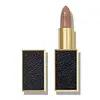What's inside
What's inside
 Key Ingredients
Key Ingredients

 Benefits
Benefits

 Concerns
Concerns

No concerns
 Ingredients Side-by-side
Ingredients Side-by-side

Pentaerythrityl Tetraisostearate
EmollientBis-Diglyceryl Polyacyladipate-2
EmollientCaprylic/Capric Triglyceride
MaskingOleic/Linoleic/Linolenic Polyglycerides
EmollientEuphorbia Cerifera Wax
Pvp
Emulsion StabilisingDipentaerythrityl Hexahydroxystearate/Hexastearate/Hexarosinate
Skin ConditioningDiisostearyl Malate
EmollientPolyethylene
AbrasiveHydrogenated Polydecene
EmollientPolybutene
Cetyl Lactate
EmollientSynthetic Wax
AbrasiveButyrospermum Parkii Butter
Skin ConditioningGlycine Soja Seed Extract
Skin ConditioningOlea Europaea Fruit Extract
BleachingTriticum Vulgare Bran Extract
Skin ConditioningCopernicia Cerifera Wax
Tocopherol
AntioxidantTocopheryl Acetate
AntioxidantAscorbyl Palmitate
AntioxidantCeramide NP
Skin ConditioningCholesterol
EmollientOctyldodecanol
EmollientSynthetic Beeswax
Emulsion StabilisingPotassium Sulfate
Alumina
AbrasiveCalcium Aluminum Borosilicate
Calcium Sodium Borosilicate
Tin Oxide
AbrasiveSilica
AbrasiveOleic Acid
EmollientPalmitic Acid
EmollientCetyl Alcohol
EmollientGlyceryl Stearate
EmollientEthylhexyl Hydroxystearate
EmollientVanillin
MaskingMica
Cosmetic ColorantCI 77891
Cosmetic ColorantCI 77491
Cosmetic ColorantCI 77492
Cosmetic ColorantCI 77499
Cosmetic ColorantCI 77163
Cosmetic ColorantCI 42090
Cosmetic ColorantCI 75470
Cosmetic ColorantCI 15850
Cosmetic ColorantCI 45380
Cosmetic ColorantCI 45410
Cosmetic ColorantCI 73360
Cosmetic ColorantCI 17200
Cosmetic ColorantCI 19140
Cosmetic ColorantCI 15985
Cosmetic ColorantPentaerythrityl Tetraisostearate, Bis-Diglyceryl Polyacyladipate-2, Caprylic/Capric Triglyceride, Oleic/Linoleic/Linolenic Polyglycerides, Euphorbia Cerifera Wax, Pvp, Dipentaerythrityl Hexahydroxystearate/Hexastearate/Hexarosinate, Diisostearyl Malate, Polyethylene, Hydrogenated Polydecene, Polybutene, Cetyl Lactate, Synthetic Wax, Butyrospermum Parkii Butter, Glycine Soja Seed Extract, Olea Europaea Fruit Extract, Triticum Vulgare Bran Extract, Copernicia Cerifera Wax, Tocopherol, Tocopheryl Acetate, Ascorbyl Palmitate, Ceramide NP, Cholesterol, Octyldodecanol, Synthetic Beeswax, Potassium Sulfate, Alumina, Calcium Aluminum Borosilicate, Calcium Sodium Borosilicate, Tin Oxide, Silica, Oleic Acid, Palmitic Acid, Cetyl Alcohol, Glyceryl Stearate, Ethylhexyl Hydroxystearate, Vanillin, Mica, CI 77891, CI 77491, CI 77492, CI 77499, CI 77163, CI 42090, CI 75470, CI 15850, CI 45380, CI 45410, CI 73360, CI 17200, CI 19140, CI 15985
Neopentyl Glycol Diheptanoate
EmollientDiisostearyl Malate
EmollientTalc
AbrasivePentaerythrityl Tetraisostearate
EmollientPolyethylene
AbrasiveSynthetic Beeswax
Emulsion StabilisingCyclopentasiloxane
EmollientCopernicia Cerifera Cera
EmollientDimethicone/Vinyl Dimethicone Crosspolymer
Skin ConditioningCaprylyl Glycol
EmollientTocopheryl Acetate
AntioxidantLecithin
EmollientTocopherol
AntioxidantAscorbyl Palmitate
AntioxidantCitric Acid
Buffering1,2-Hexanediol
Skin ConditioningTropolone
Skin ConditioningAroma
CI 77891
Cosmetic ColorantIron Oxides
CI 42090
Cosmetic ColorantNeopentyl Glycol Diheptanoate, Diisostearyl Malate, Talc, Pentaerythrityl Tetraisostearate, Polyethylene, Synthetic Beeswax, Cyclopentasiloxane, Copernicia Cerifera Cera, Dimethicone/Vinyl Dimethicone Crosspolymer, Caprylyl Glycol, Tocopheryl Acetate, Lecithin, Tocopherol, Ascorbyl Palmitate, Citric Acid, 1,2-Hexanediol, Tropolone, Aroma, CI 77891, Iron Oxides, CI 42090
Ingredients Explained
These ingredients are found in both products.
Ingredients higher up in an ingredient list are typically present in a larger amount.
Ascorbyl Palmitate is created by combining pure Vitamin C and palmitic acid. It is an antioxidant and helps reduce hyperpigmentation.
This ingredient is a more stable version of Vitamin C, meaning it does not disintegrate as quickly when exposed to sunlight. However, studies show it does not penetrate skin as well as pure Vitamin C.
Ascorbyl Palmitate is oil soluble.
Read more about other types of Vitamin C:
Learn more about Ascorbyl PalmitateCi 42090 is a synthetic dye created from petroleum. It is used to give a bright blue color to cosmetics, medicine, and food.
Ci 77891 is a white pigment from Titanium dioxide. It is naturally found in minerals such as rutile and ilmenite.
It's main function is to add a white color to cosmetics. It can also be mixed with other colors to create different shades.
Ci 77891 is commonly found in sunscreens due to its ability to block UV rays.
Learn more about CI 77891Diisostearyl Malate is an emollient and most often used in lip products. It comes from isostearyl alcohol, a fatty acid, and malic acid, an AHA.
As an emollient, Diisostearyl Malate helps create a thin film on your skin to trap moisture in. This helps keep your skin soft and smooth.
Pentaerythrityl Tetraisostearate is derived from isostearic acid. It is an emollient and emulsifier.
The highest concentration of this ingredient is found in lipsticks.
This ingredient is minimally water soluble and may not be Malassezia folliculitis, or fungal-acne safe.
Learn more about Pentaerythrityl TetraisostearatePolyethylene is a synthetic ingredient that helps the skin retain moisture. It is a polymer.
It is also typically used within product formulations to help bind solid ingredients together and thicken oil-based ingredients. When added to balms and emulsions, it helps increase the melting point temperature.
Synthetic beeswax is created to be identical in structure to beeswax. It possesses the same occlusive and emulsion properties.
A blend of fatty acid esters, fatty acids, and alcohols are used to create synthetic beeswax. Whether or not this ingredient is vegan depends on the source. Sometimes, lanolin is used for its creation.
This ingredient may not be Malassezia folliculitis, or fungal-acne safe.
Learn more about Synthetic BeeswaxTocopherol (also known as Vitamin E) is a common antioxidant used to help protect the skin from free-radicals and strengthen the skin barrier. It's also fat soluble - this means our skin is great at absorbing it.
Vitamin E also helps keep your natural skin lipids healthy. Your lipid skin barrier naturally consists of lipids, ceramides, and fatty acids. Vitamin E offers extra protection for your skin’s lipid barrier, keeping your skin healthy and nourished.
Another benefit is a bit of UV protection. Vitamin E helps reduce the damage caused by UVB rays. (It should not replace your sunscreen). Combining it with Vitamin C can decrease sunburned cells and hyperpigmentation after UV exposure.
You might have noticed Vitamin E + C often paired together. This is because it is great at stabilizing Vitamin C. Using the two together helps increase the effectiveness of both ingredients.
There are often claims that Vitamin E can reduce/prevent scarring, but these claims haven't been confirmed by scientific research.
Learn more about TocopherolTocopheryl Acetate is AKA Vitamin E. It is an antioxidant and protects your skin from free radicals. Free radicals damage the skin by breaking down collagen.
One study found using Tocopheryl Acetate with Vitamin C decreased the number of sunburned cells.
Tocopheryl Acetate is commonly found in both skincare and dietary supplements.
Learn more about Tocopheryl Acetate